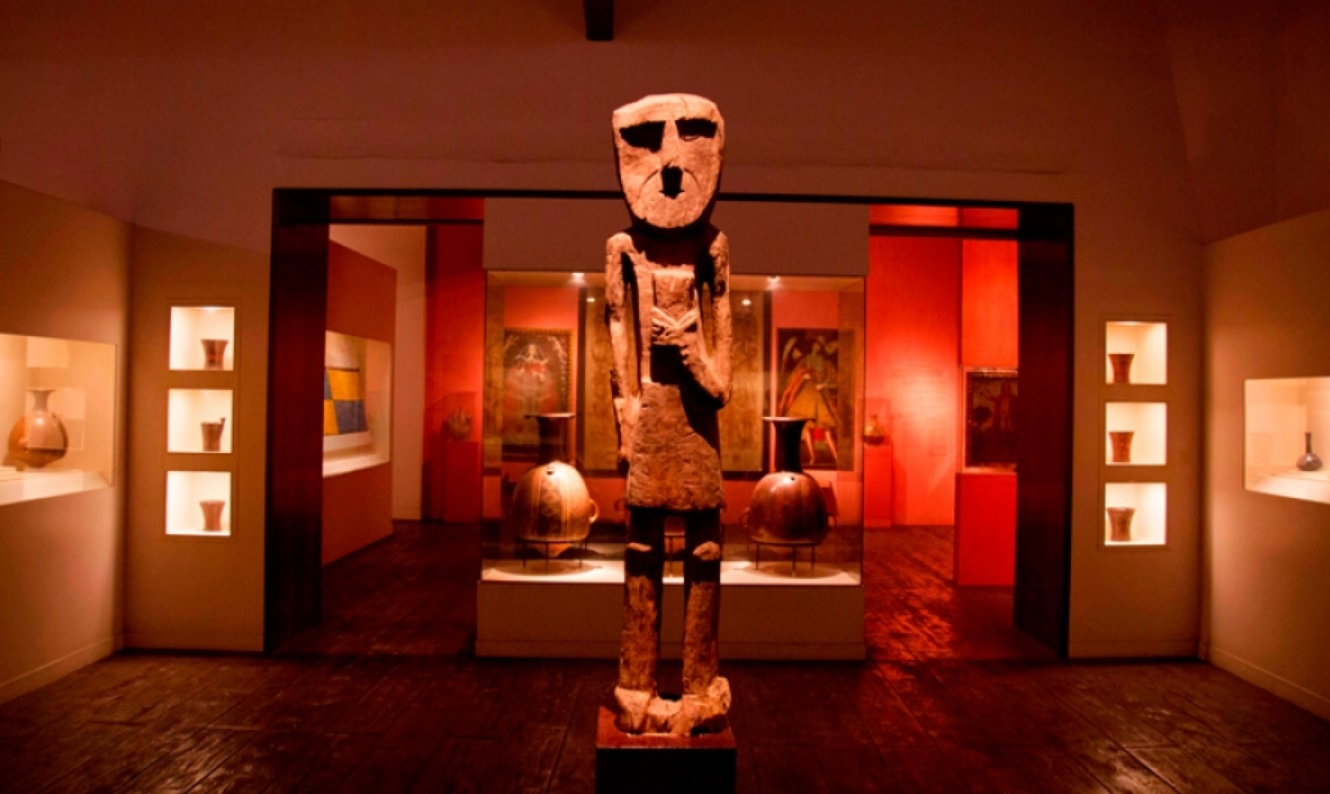
30 Oct TIO Peru: In General & Lima
Our whirlwind tour of Peru, just under two weeks, was choreographed by the award-winning Kensington Tours, whose “destination experts” (like ours, Sarah Roberts) are good listeners. Sarah curated to our wants and needs down to the smallest details: yoga mats in hotel rooms and hiking poles for walking the Inca Trail and exploring Inca sites like Machu Picchu, because, well, as one of our guides said with wink on or about mile 7, the Incas really liked steps. “Getting high” back in 15th century meant climbing mountains to get closer to the gods – sun, stars, constellations – and safety from enemies. And what goes up…
Scroll down to the bottom of the story for more information about a few things to consider when booking your trip. And here’s a link to another well thought out story on the subject.

Machu Picchu in all its glory and one of the new Seven Wonders of the World.
In general:
There’s gold in them thar’ hills.
Or under lakes.
But the big question remains where.
Like all persistent legends, the folklore about the lost city of El Dorado or City of Gold contains bits and pieces of truth.
Descendants of the Incas tell that when the “españarris” entered Cusco, in the early 16th century they mistook the invaders for the sons and daughters of the sun because their skin was so light, their tall bodies were covered in shiny armor and they were astride an animal (horses) locals had never seen before.
When they reached Cusco, the Spanish conquistador Pizarro betrayed them by taking the son of the Sun prisoner, who then offered to pay for his own rescue. The prince promised to fill a whole room of gold and silver until it reached above the Emperor – with his hand stretched up. Blinded by the light of the unending caravans that came from all over the land to pay the ransom, the story goes Pizarro thought that if these people were willing to give up such treasure without a fight, there should be more. He supposedly ordered his men to look under every stone to find gold and jewels that perhaps only existed in his imagination. However, when word spread the rescue had not satisfied Pizarro’s greed, purportedly the balance of the Empire’s gold got buried in the ground or tossed to the bottom of lakes.

Jacques Couteau
Believing the legend might well be true, centuries later, in the late-19060s, the legendary underwater explorer Jacques Cousteau became the first man to search the giant Lake Titicaca for the lost city. However, instead of gold, he found a population of millions of strange frogs and toads including the Titicaca water frog, aka the scrotum frog due to its baggy skin, one of the largest aquatic frogs in the world, now endangered due to pollution from cities like Puno.
Like so many before us, we decided to take a deep dive into Peru to discover the cultural riches of Machu Picchu. But we stayed and found the wealth of the country goes well beyond one of the new Seven Wonders of the World.
Despite the worst efforts of the Spanish conquistadors who literally and metaphorically tried to plaster over that history, many of early Peru’s traditions have remained: food, arts, crafts, natural medicines and a warm, welcoming people. Among our new acquaintances were descendants of Incan and other pre-Columbian cultures. Jaw-dropping landscapes and hidden high elevation hamlets and island-based clans rounded out the pretty and pretty darn interesting picture.
Among those traditions past and present, quirky and not:
• Honoring royals and gods by building their homes and temples not with indigenous rocks, too easy. Special rocks suitable to the rank of the would-be occupants were chosen, including giant boulders, some weighing many tons. Those had to be transported from miles away by a small army of workers – without the help of beasts of burden. The resulting structure was perfectly constructed, quake-proof; seams created with copper edges could not be penetrated. However, the Spanish invaders saw fit to plaster over those rocks (also gorgeous mosaics) to build their kitschy edifices, especially churches. However, when one of their churches crumbled in a quake – the main house of worship in Cusco – the only thing left intact was the Incan structure the edifice was built on. So who got the last laugh?
• Telling stories of man and gods through beautiful decorated ceramics and textiles like the ones we discovered in Museo Larco in Lima. And in certain indigenous cultures, hats do the talking: on Taquile Island, like Machu Picchu a Unesco site, if the pompom on your head-covering hangs to the right that means you are happy; to the left, you are having a bad hair day. If the day is windy, it’s really hard to tell whatup.
• Mummifying the dead and wrapping the remains in layers of woven blankets. Once preserved in that manner, Incan kings still ruled. Their bodies were carried around by a team of beautiful women. (Who did the talking for them, natch.)
• Young men signaling their desire for a mate by catching the light of the sun on a mirror and directing it at their target. If a lady should find the gent desirable, she would flash back with her mirror. If not, she would toss a handful of pebbles in his direction to tell the annoying boy to get lost.
• Diagnosing maladies using black guinea pigs. The healer or curandero rubs the animal over the patient’s body and then analyzes the body of the guinea pig to determine what is wrong with the patient. One of our guides kept a collection of 75 guinea pigs. Once diagnosed, with or without the benefit of pigs (or flowers in some cases), all of our highly intelligent guides stated they preferred using natural healing aids to cure themselves or family members to modern, allopathic meds – though none ruled out the latter entirely. That said, a clinic in Titicaca offering Western medicine is essentially closed down; locals have rejected the services. For one small example, if viagra is needed getting it is as simple as eating a particular species of blue potato or drinking the sap of a certain palm trees. (The roots of the tree that excretes male viagra are shaped exactly like penises).
• Tying adulterers to a tree that is home base for red or “fire ants.” The ancient practice is still in effect among the locals in Port Moldonado, the entrance to the Peruvian Amazon. Unlike many other ants, which bite and then spray formic acid on the wound, fire ants only bite to get a grip and then sting (from the abdomen) to inject a toxic alkaloid venom. For humans, the sting is very painful — hence the name. The after-effects can be deadly. Got the picture?
Not guilty.? Well then, let’s move on to…
Lima, the alpha & omega of our trip:

We began and ended our vacation with all-too-short stays in Lima.
About six years ago the world discovered ceviche. Since then food is fast becoming Peru’s new gold with Lima emerging as the new Copenhagen and restaurants featuring Peruvian delicacies popping up all over the world, from London and Los Angeles to Seattle, San Francisco and Singapore. In fact, according to the “World’s Best Restaurants” (and, umm, word-of-mouth), Lima is widely considered one of the hottest food capitals in the world today.
Peru’s culinary genius has been centuries in the making: partridges, grains, stews and roasts of the Andean Incas came to share the table with Iberian and French cuisine brought by invading Spanish conquistadors starting in 1532. Yummy fusions came as Italian, Chinese, Japanese and African immigrants entered the picture. In addition to the parade of emigres on top of indigenous know-how, the nation’s rich biodiversity also explains the banquet of tastes: tropical fruits from the Amazon; tubers (including 4,000 varietals of native potatoes alone) from the Andes; and fish from Pacific among them.
We asked a very woke concierge at Hotel B, our uber trendy digs in Lima, for a list of the top restaurants in the city today. Her response: Maido, Rafael, Amoramar, Fiesta for fine dining; Isolina for casual dining; El Mercado and La Mar for ceviche. Then there is Chez Wong for a four-course tasting lunch (only). Off the list of the best of the best is Astrid y Gaston, although much of the initial excitement about Peruvian food began with Gaston Acurio. Word on the street is the uber restauranteur has just gotten too big for his britches, expanding so far and wide his flagstaff has lost its luster for lack of attention to details. And when it moved from its intimate space to a larger site, Central allegedly lost some of its original magic too.
In truth, that list could easily be expanded. Even the hotels we stayed in offered super fresh, beautifully plated, memorable meals, breakfast, lunch and dinner.
The hottest chef in town right now? No doubt it’s Mitsuhara Tsumara of Maido. We tried, even used pull, (an ambassador friend who was joining us for the evening and knows Tsumara very well), but the only opening the one night we were available was 10:30 p.m.. Since our pick-up the next morning was 6 a.m. that was not going to work. Our default was Rafael, which is owned by Chef Rafael Osterling and housed in a beautiful Art Deco townhouse in chic Miraflores.
Osterling used to be a lawyer and had considered a diplomatic career before deciding to follow his bliss, which was to study at Le Cordon Bleu and work in restaurants in Paris and London. He opened Rafael in 2000; the place was #24 on Latin America’s 50 Best Restaurants 2018.
Rafael celebrates Peru’s eclectic food culture in understated elegance. Our late, light meal included mini pancakes filled with Peking Duck and sea urchin pasta.
On the very last day of Peruvian adventure, our travel agent managed to get us a 1 p.m. reservation at Chez Wong, which is housed in a little residential building in the very vanilla Santa Catalina district. There is no sign on its nondescript door. The room inside is much the same: lackluster and decidedly downtown. However, the wall behind our table was plastered with newspaper clipping depicting celebrity Chef Javiar Wong’s culinary exploits. Among his fan base was the dearly departed Anthony Bourdain.
Chez Wong is purportedly among Lima’s best cevicherias and our first course did not disappoint.
That was followed by three different stir fries, which, like the ceviche, were all based on Chef Wong’s central ingredient: flounder. Everything was prepared about three feet from our table, the visual spectacle almost as exciting as the meal itself.

Clint with Chef Wong
However, beyond the food, there are worlds worth exploring in Lima, a fascinating microcosm of Latin America old and new, finally emerging from its unfortunate handle: “Lima the Ugly.” And, in a region where the economic outlook is almost uniformly negative, Peru has emerged in recent years as one of South America’s shining stars with Lima, which holds one-third of the country’s population of about 33 million, leading the charge. However, the gaping maw between the haves and have nots in the city (and elsewhere in the country) must be mentioned. (We were told one of those wealthier districts in Lima is now trying to pull a trump, asking if it can build a wall to shut off views of a poor neighborhood nearby.)
For many, as stated above, Lima has historically served primarily or only as a jumping off point for onward journeys to the ruins of Machu Picchu. But authorities today are hoping to position the city as a regional hub not only for leisure tourism, but also for business. And according to one source, the current president is chasing down the rampant corruption that began with the reign of Fujimori in 1990, who, yes, ended the reign of terror of the Shining Path and stimulated the economy, but who also profited from his fix, partnering with drug dealers and eager actors from all branches of the bureaucracy – including judges and cops.
The first night, on a the very hectic car ride into town from the airport, we passed a crumbling coastline that now includes modern skyscrapers jostling for space next to deteriorating colonial facades. Everywhere we looked, sleek, new apartment buildings seemed to being popping up like giant beanstalks over or near dusty old relics which they dwarfed.
Beneath an alabaster fog known as the garua, which veils the city from June to October, there are gorgeous Art Deco and Beaux Arts facades of the restored and up-and-coming colonial seaside quarter of Barranco, where Hotel B is located, plus museums and hip galleries, including homeboy Mario Testino’s quietly elegant Museo Mate, which we visited our last day in Peru (after the aforementioned lunch at Chez Wong). A must.
We also stopped by 80 Metres, another top gallery in the district. Other recommendations on a list put together by the curator of the unending art collection at “B”: Wu and Crisis. (B” provides a map for a walking tour of other possible art stops.) Sadly we had no time to tour other great galleries in San Isidro and Miraflores, the districts which are also homes to embassies and major businesses, but we did take a quick drive through the wonderful parks in those neighborhoods.
At the start of trip, on our very first full day in Lima, our guide took us to Museo Larco, where we toured with an associate scholar of the museum that is arguably the most comprehensive collection of pre-Colombian art in the world. If you see nothing else in Lima, don’t miss this stop. And ask to be guided through 5000 years of Peruvian history by David Rodriguez or one of his deeply knowledgable curatorial colleagues. That tour through Peru’s early history grounded us for the rest of the visit.
The Larco family, originally Italian immigrants, built its fortune on sugar cane. In 1926, at the age of 25, Rafael Larco Hoyle founded the Museo Larco. With the help of his father, he managed to acquire several archaeological collections from Peru’s northern coast, bringing together some 45,000 pieces from a wide range of indigenous cultures, including ceramics, pottery, textiles, all of which tell stories of men and their gods in a world divided by the Inca into three parts, each with an animal analog: snake for the underworld where it signified wisdom and acts as a guide to a new life; condors, which mediate between the world of man and the gods in the heavens; and the puma, a symbol of power and strength of the gods, the sun, stars and constellations. You see those symbols everywhere, even on t-shirts sold in local markets.

Image courtesy Museo Larco.

Image, courtesy Museo Larco
The Larco collection also includes precious metal artifacts, plus elegant jewelry and the simply elegant quipu (or khipu), a binary system of colored knots and strings used for accounting and to inventory stores of corn, beans and other provisions. Incan quipus also supposedly encoded history, biographies, letters and more, acting in effect as ancient computers whose depth of application and meaning were lost when the Spanish murdered the nobility – including those trained to decipher the codes. However, anthropologists are not giving up, hoping to break the code into syllables and words.
The museum also has a special section dedicated to erotica. Apparently priests and nuns, taking a leaf from the Kama Sutra, had at it in all kinds of imaginative ways in order to produce an offering of semen to Pachamama, goddess of fertility.
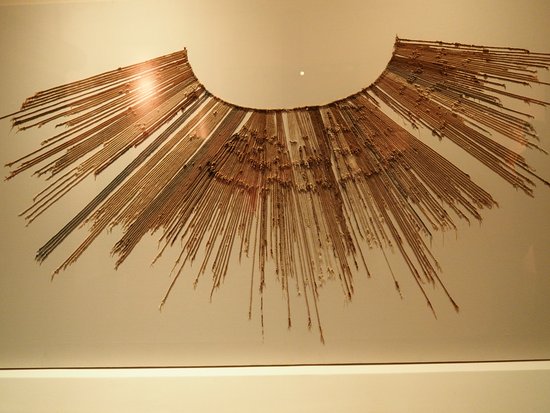
The big takeaway from Larco? The intimate bond between pre-Colombian art and the natural world of Pachamama or Mother Nature, revered by the indigenous people of the Andes. The goddess presides over planting and harvesting, is embodied in the mountains, and causes earthquakes.
(The ongoing tradition of worshipping Mother Earth may be at the roots of a big green push throughout the country. Recycling is everywhere, including at Machu Picchu and promoted in every hotel.)
That same day we also checked out the Plaza Mayor where the Government Palace and City Hall are located. We visited the San Francisco Convent, an example of Spanish Baroque architecture, the original dating back to 1674.
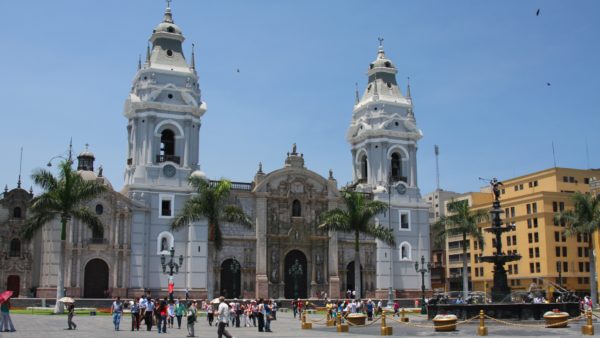
Its catacombs hold the bones of 25,000 buried there prior to the opening of Lima’s cemetery. Somewhat interesting, though honestly, once you’ve seen one femur bone, one shin bone, you’ve seen them all. We made a run through. Best part of that part of the visit to the church complex was its library, which holds 25,000 antique texts, some predating the conquest.
Another highlight are the compound’s 13 paintings of the biblical patriarch Jacob and his 12 sons in the Refectory created in the studio of the Spanish master Francisco de Zurbarán, a favorite painter of ours.
A quirky last supper painted by Diego de la Puente depicts typical Peruvian ingredients and meals such as guinea pig, potatoes and chillis. Also peculiar, though absent from the DaVinci version, is the Devil hovering besides Judas.
The monastery also houses several paintings attributed to the school of Peter Paul Rubens.
More about Hotel B:
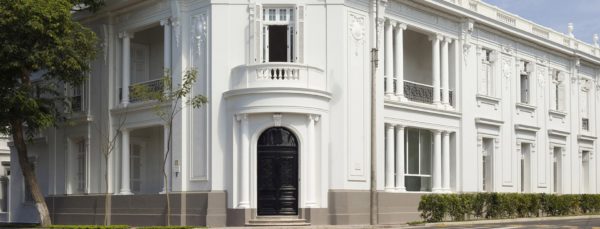

Sitting area just outside our second room at B.
As we’ve said, home base in Lima was Hotel B, a Relais & Chateau property, though spendy, was worth every penny (rather dollar) to enjoy one of its 20 uniquely appointed rooms.
The beautifully renovated Belle Epoque building stands proudly once again on a corner of the Barranca district, now experiencing the kind of renaissance New York’s Soho and Tribeca enjoyed back in the 1970s and 1980s. In fact, the barrio today is home to many of Peru’s best-known artistic talents – such as Testino. But that was not always the case: When urban sprawl encroached upon what was elite enclave in the 19th century, wealthy Limeñans skipped and squatters took up residence in the abandoned, decaying mansions.
B’s facelift was completed about five years ago and features exotic woods, a columned bright white facade, open balconies and sky-high ceilings lit by skylights in the roof. (One of our two gorgeous rooms had 30-foot ceilings, along with a glass cage of a shower/sauna structure that was itself a work of art.)
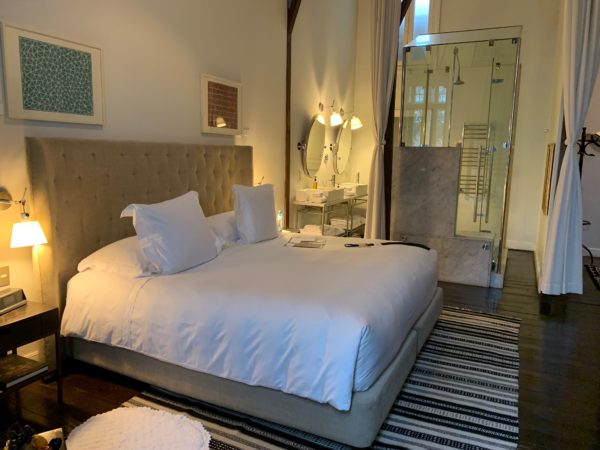
Our second room, Hotel B
Not too surprisingly, Hotel B also boasts service with a smile, from bellhops to front desk staff and its curator, Monica, whom we were privileged to meet.
Monica took me on a tour of the hotel’s art collection, linked directly to two of B’s owners, Lucia de la Puente and her sister, the well-known art collector, Susan de la Puente. Approximately 300 works, some by contemporary Peruvian artists like Jose Tola, are on display in the public spaces and in the rooms.
A Tola canvas titled “Blonde Singer” hangs over the hotel’s trendy bar.
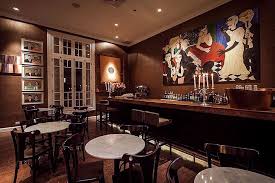
The image depicts a club scene that could have been plucked straight out of Star Wars. One of Tola’s signature moves is to paint his subjects with just four fingers. An interesting statement considering the fact it is our opposable thumbs that help distinguish man from most other beasts. So is Tola saying his characters, in fact all of us, are aliens in this world? Ironically the central figure of the blonde who gives the work its name has no hair at all. So can she sing? Or does the absence of a blonde mane signify a loss of her powers? Are we all pretending like her? All aliens parading around as humans, talented or otherwise?
On one wall in the library (or breakfast/tea room) is a startling black-and-white photograph of a young woman, a Madonna standing waist-deep in a sea of piranhas. (The meaning is obvious, no?) And, to underline to point, on the opposite wall is a colorful photograph of a clown who stares in the direction of the nubile teen.
(B’s curatorial team obviously has a great sense of humor.)
The variety of works on display is jaw-dropping: prints depicting street scenes from a artist working in the 19th century juxtaposed to prints of streets scenes by a contemporary artist; African ceramics; a pre-Columbian funeral mask, a textile band holding the hair of the deceased in place; video art; Alberto Casan’s conceptual art; Aldo Chaparro’s crushed and colored stainless steel installations; even dolls.
Miguel Aguirre’s abstraction in the lobby honors both Rothko and chicha music, acid hot with colors to match. On the wall opposite the Aguirre is Victor Rodriguez’s hyper-realistic portrait of one of his muses titled “Velvet Water.” Is the artist saying the woman is as pure and soft as water? Regardless the Rodriguez portrait has the look of an Alex Katz.
The art in our room is all about patterns, linear and random. A large photo of a poor man sitting in front of a tangle of branches dominates. Over our bed, the theme of tangles, this time in the form of prints, continues. On another wall, Christian Zuzunaga’s geometric abstraction of a street in Lima from an aerial perspective echoes Mondrian’s Broadway Boogie Woogie. Outside the glass enclosed shower is a sexy, surreal image of a voyeur, the artist, oogling his muse, who happens to be his wife. Who in turn is being caressed by an androgynous figure that might represent a fusion of the husband and wife.
Hotel B’s massive art collection becomes a meta for the the city of Lima and perhaps for Peru as a whole. It is hung with an eye towards playfulness and fun, not coherence. It therefore represents a clash of cultures and eras that magically works harmoniously in the end to create an adventure for the eye – and for the head and heart.
Next up the Amazon and the Sacred Valley.
But before you go, please note the following when planning your trip to Peru:
We chose to work with an agent for a number of reasons: to save time we did not (and do not) have for meticulous planning; to coordinate the – forgive the expression – mountain of details involved with touring places like sacred Incan and pre-Incan sites and survey tours of third-world countries in general. Also because we felt safer sending our money to a company with an international reputation rather than one of a number of unknown guides (some of whom we found out work “informally,” as in off the books) capable of planning the trip. Should you choose to work with a local guide, be sure to look for a certification by the Peruvian Ministry of Tourism. Some agencies and guides look good on the page, but all too many people have bought a package online and upon arriving in the country, found no one home. They had been tricked.
Caveat emptor.
Many of the places we visited require guides; there is no workaround. We felt more comfortable having Kensington select ours using a company it has worked with for years and having that agency choose the ones best suited our stated objectives, which Kensington sent their way.
Did we see everything we might have wanted to see? No, of course not, not in two weeks. Had we had more time, we might have stayed longer in Lima and visited the Callao district, one of Lima’s most notorious, now experiencing an artistic renaissance. We might have swum with turtles. Visited Rainbow Mountain in Cusco. Seen the Nazca Lines in southern Peru, 11,00 pre-Colombian geoglyphs etched in desert sands and only visible from the air. Ask about those options when planning your Peruvian adventures. Meanwhile, we were satisfied with all we did manage to take in, which was a lot, again, thanks to our travel agent.


Sorry, the comment form is closed at this time.